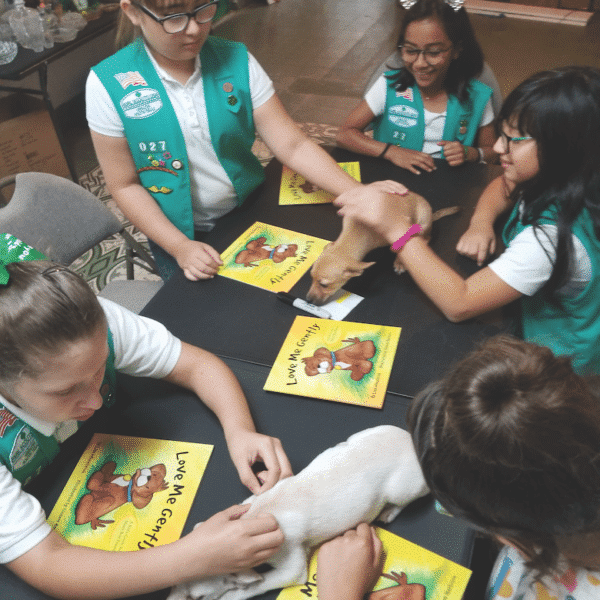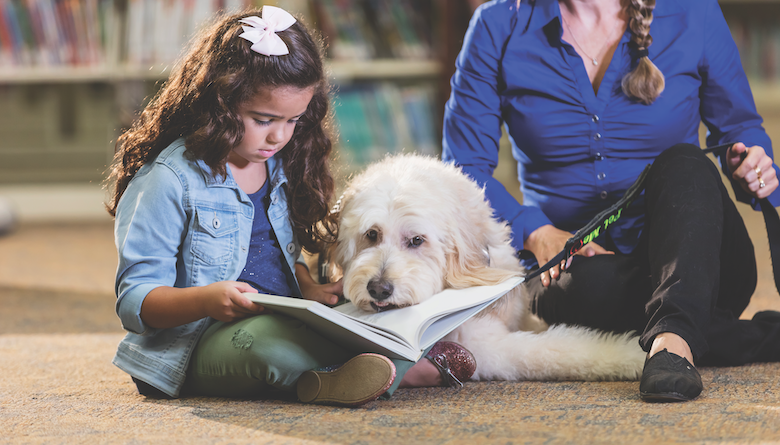Kids + Animals = Kindness and Compassion
Teachers aren’t always aware when a student in class is homeless
or living in an orphanage. And that child, as you can imagine, may feel embarrassed to share his or her story with classmates for fear of being ostracized.
What helps that child feel more comfortable? A rescue dog sharing his story first.
“(The kids) can relate to the journey of the rescue pet,” says Jayne Vitale, director of education and youth programs at North Shore Animal League America, whose program uses the natural affinity between kids and pets to teach social emotional learning skills. “Look across the classroom; we are all mixed breeds,” she says of the lessons she directs in 4,000 schools and libraries nationwide, using rescue dogs as a model of resilience and hope.
Jayne runs the New York-based shelter’s Mutt-i-grees program, a curriculum developed by Yale University for pre-K to high school aged-kids. Many children, especially those with autism, can identify feelings in dogs better than in people.
Programs like Mutt-i-grees exist around the country and emphasize the reciprocal relationship between kids and dogs. Through learning how to be responsible and considerate toward a pet, kids can strengthen their own ability to connect with others and be an ambassador for kind animal — and human — behavior.

Giving and getting help
Every child can get involved in some way, as long as it’s age appropriate.
That’s the premise behind Lisa Wiehebrink’s books, Love Me Gently and Gray Whiskers, written about her rescue dog, Cooper, which she eventually used as the framework for her nonprofit Tails That Teach.
“The way kids treat animals is oftentimes how they will treat people,” says Lisa, who started the program in 2017 and partners with hundreds of schools and shelters nationwide.
Lisa’s books, which are part of a larger kit with a little stuffed Cooper dog, are used for schools’ anti-bullying and kindness weeks, as a gift to families who adopt shelter dogs and community outreach programs.
Related: Kids Reading to Shelter Dogs Help Both Gain Confidence

They teach young kids why we always keep a dog’s collar on, not to poke a sleeping dog and to let a dog eat uninterrupted.
“The underlying theme is kindness to all,” she says. “If we can get these kids at these young ages to be kind and compassionate and responsible, as they get older, they will become compassionate and responsible adults.”
In 2018, Lisa founded National Rescue Dog Day on May 20, which has helped to take the stigma off shelter dogs, mainly by inviting people, and kids, to share photos of their rescues on social media (so far there are 45,000 hashtags dedicated to the day).
The programs aren’t designed as a one-time lesson; they’re meant to stick with the kids long term and supply them with enough confidence as they grow that they’ll continue to encourage others in their communities to help.

Empowering kids to spread the empathy message
In southern Utah, Best Friends Animal Society launched a junior ambassador’s program in 2019 to give kids an avenue to share their love of animals.
“This is a great way for them to take what they learned home to their own communities,” says Jess Carter, acting manager to the visitor and welcome center.
Related: Take a Look Inside the Best Friends Internship Program
Eight to 13-year-olds can visit the Best Friends Animal Sanctuary, a refuge to nearly 1,600 homeless animals, volunteer their time to help care for and play with the animals, and learn what it takes to save these animals’ lives.
At the end of the tour, kids take an oath to promote animal welfare by finding new ways to get involved in their own communities, and they receive a junior ambassador’s badge.
“It is important to empower kids and let them know they can make a difference in the lives of animals,” Jess says. “They will be the ones fighting for the animals in the future.”
#PawsPawsForThisCause
Bring these programs to your child’s school. They can be incorporated into the school’s existing curriculum. For more information or to download resources, visit education.muttigrees.org and tailsthatteach.org.
Familiarize your kids with the local shelter. The stigma against adoption dissipates as kids interact with rescue pets, become emotionally attached to them and empathize with their life stories.
Assign your kids age-appropriate pet responsibilities at home. Giving your kids a sense of what it feels like to have another living creature rely on them teaches commitment and builds self-confidence.





Kamagra tablets https://kamagra.icu/# – super kamagra